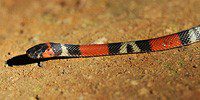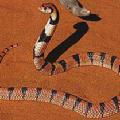
Cape monitor lizard
The Cape monitor lizard is also called the Bosca monitor lizard or the steppe monitor lizard (lat. Varanus exanthematicus) is a species of reptile from the monitor lizard family. This name of this species is erroneous, since this animal does not live in the Cape Mountains, but since it was first brought to Europe and described from South Africa, this name has stuck with it to this day.
Subspecies of this lizard are not distinguished. However, some herpetologists in their works describe 4 subspecies based on their habitat, but almost all taxonomists recognized them as invalid, and the species is considered integral.
These animals in adult form have a body length with a tail of 80 – 110 cm and up to 2 meters. Their body is atypical for monitor lizards, as it is rather overweight, but it fully corresponds to the life activity that the animal leads. That is, it is aimed at the endurance of the body and saving vital energy, and not at climbing trees and diving in water.
Cape monitor lizards have a short body and muzzle, it has obliquely set nostrils, shaped like slits, located very close to the eyes. These animals have short fingers with very large claws. The body of the lizard is covered with small scales, the tail is laterally compressed and has a double crest on the upper edge. The color of these reptiles has a gray-brown gamut with yellow stripes and spots. The lower side of the body of the monitor lizard is lighter than the back, the throat is yellowish-white, and brown and yellow rings are pronounced on the tail.
Distribution
Cape monitor lizards are distributed in field zones from west to east of central Africa, in Benin, Burkina Faso, Cameroon, the Central African Republic, Chad, the Democratic Republic of the Congo (Zaire), Eritrea, Ethiopia, Gambia, Ganoia, Guinea, Guinea Bissau, Ivory Coast, Kenya, Liberia, Mali, Nigeria, Nigeria, Senegal, Sierra Leone, Sudan, Togo and Uganda.
Life in nature
 In nature, Cape monitor lizards live in savanna and semi-desert biotopes, dry forests, rocky savannahs, arid scrubs (bushes) and foothills. This lizard leads a terrestrial lifestyle, showing diurnal activity. As a shelter, reptiles dig holes on their own, or using ready-made ones that belonged to rodents. Monitor lizards also settle among piles of stones, crevices and at the roots of trees and bushes.
In nature, Cape monitor lizards live in savanna and semi-desert biotopes, dry forests, rocky savannahs, arid scrubs (bushes) and foothills. This lizard leads a terrestrial lifestyle, showing diurnal activity. As a shelter, reptiles dig holes on their own, or using ready-made ones that belonged to rodents. Monitor lizards also settle among piles of stones, crevices and at the roots of trees and bushes.
When an aggressor appears next to him, the Cape monitor lizard turns sideways to him, swells up, bends the tail to the opposite side of the body and brings it in for a strike. If, when danger arises, the lizard cannot hide anywhere and thereby escape, it clings to the stones so strongly that it is almost impossible to tear it off.
With the onset of a hot time of the day, animals hide in their shelters and leave there only with the onset of coolness. Cape monitor lizards can climb low on trees and shrubs, where, hiding in a zone of relative ventilation, they can lie in wait for their prey.
This species of animal is very territorial and therefore always adheres to the boundaries of its site.
In the wild, the diet of the lizard is represented mainly by carrion. They also hunt, preying on small mammals, insects, frogs, crayfish and the like. Varan eats everything: from internal organs to bones. He does not chew food, but bites off large pieces of it and swallows it.
After the animal has eaten, it lies down half asleep to digest what it has eaten, at this moment the activity of the animal is reduced and it is relaxed. Monitor lizards show any kind of activity only when they are in danger or they are hungry.
This reptile is often found near rivers and lakes and, therefore, local natives consider them sacred animals and believe that the death of these animals will lead to a decrease in the amount of water.
Life in a terrarium
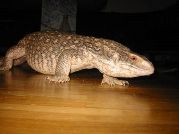 Before you get a Cape monitor lizard in an apartment as a pet, you must understand that this will require both material and time costs from you, as future owners.
Before you get a Cape monitor lizard in an apartment as a pet, you must understand that this will require both material and time costs from you, as future owners.
Cape monitor lizards require a horizontal terrarium for Palearctic animals. The dimensions of such a terrarium should be 120 cm long and 60 cm wide per animal. and a height of 50 cm. A certain temperature must be maintained in it, this can be achieved by using a thermal stone, thermal mat or using an incandescent lamp. In the place where the heater is located, the temperature during the day should be up to +32 degrees, at night +25 degrees, where it is not, +28 during the day, and +20 degrees at night. In the area where a high temperature regime is maintained, there should be a large stone, branch or shelf, since the monitor lizard needs to warm up well, stretching out with its whole body on a hill. These animals will feel much more comfortable if they have a shelter in the terrarium, such as a stone strong grotto, a shelf, all kinds of houses and the like. As a filler, it is best to use an artificial turf with a pile height of 2 mm. You can also pour coarse gravel or sand on the bottom. The monitor lizard in the terrarium should have a small pool (reservoir), of such size that the lizard could fit there and a drinking bowl from which the animal will drink. Every day the terrarium should be sprayed with fresh, warm, not stagnant water.
In addition to the usual incandescent and light bulbs, a new home for a monitor lizard should have an ultraviolet lamp from ReptiGlo with a spectrum of 8.0 or 10.0 radiation units. They should burn the animal for 12 hours every day. The Cape monitor lizard during its active daylight hours and the temperature in the terrarium should be 12 hours a day.
These lizards are full-fledged predators. In their natural habitat, during a period of drought, they cannot receive enough food and therefore gorge themselves on it “in reserve”. This explains their tendency to obesity.
Feeding these reptiles at home should be varied and nutritious. They need to be given invertebrates (insects, spiders, molluscs) and vertebrates (small mammals, birds, eggs, reptiles) animals. Young Cape monitor lizards are fed crickets, cockroaches, zoophobuses, earthworms, pebbles, and later monthly mice. In adult lizards, their diet should include mice, rats, hamsters, chickens, eggs, frogs, and fish.
Monitor lizards do not care about live food or not, so they can be given meat (but not fatty) and offal, but they should not be abused in any case, since reptiles must eat the whole animal, that is, with bones, skin and internal organs. Only before giving the monitor lizard frozen food or food from the refrigerator, it must first be thawed and warmed up, since cold food causes severe indigestion in animals.
The frequency of feeding monitor lizards should be at least once every two days, and preferably daily, but do not forget about the tendency of animals to become obese and, therefore, if the reptile begins to get fat, then it is necessary to reduce the amount of food given.
It is also necessary to give the monitor lizard vitamin and mineral supplements such as Repti Life and Repti Cal.
The lizard should have water constantly and change regularly, but at least once a day. Warm water should always be poured into the drinker, without signs of stagnation and spoilage.
Needless to say, all the products that you give to the monitor lizard must be fresh, without mold, areas of sliminess and other defects. Live food intended for consumption should be clinically healthy and, if possible, free of helminths and parasitic insects.
Always remember that half of a monitor lizard’s health is in the conditions of its maintenance, and the rest in its feeding. Therefore, healthy food is a healthy monitor lizard.
Physiology
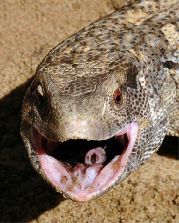 In Cape monitor lizards, there is no difference in color between male and female, so it is impossible to determine who is in front of you. In males, compared to females, the tail is slightly thicker at the base, however, this is not very well visualized due to the overall thickness of the tail as such. An accurate determination of the sex of an animal is possible only when setting up the method – sex – test.
In Cape monitor lizards, there is no difference in color between male and female, so it is impossible to determine who is in front of you. In males, compared to females, the tail is slightly thicker at the base, however, this is not very well visualized due to the overall thickness of the tail as such. An accurate determination of the sex of an animal is possible only when setting up the method – sex – test.
Lizards become sexually mature at 3-4 years of age, reaching an adult animal in size.
The breeding season, like other monitor lizards, falls on the wet season, that is, the rainy season and is a time of increased aggressiveness. Males constantly pursue females, often preventing them from eating normally. When they catch up with their partners, they grab them with their teeth in the neck area and, holding them, insert their hemipenises into them. The copulation process lasts approximately 15 minutes. After that, the female lays eggs after 45 – 65 days. To do this, she digs a hole under them in the sand or earth about 10 cm deep in a humid, but not damp place. The number of eggs in a clutch ranges from 25 to 30 pieces, but sometimes it can reach up to 40. After 170 – 180 days, small monitor lizards are born from them. They are fully formed and ready for independent life. They begin to feed from the moment they finish the assimilation of the yolk reserve.
Facts
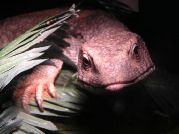 1. When kept at home, Cape monitor lizards are quite aggressive.
1. When kept at home, Cape monitor lizards are quite aggressive.
2. When a person is bitten by a monitor lizard, the wound itself is not as dangerous as the occurrence of severe inflammation up to sepsis, since pathogenic microorganisms are abundantly present in the oral cavity of lizards.
3. Listed in Annexes I and II of the Convention on International Trade in Wild Animals (CITES).
4. Most of the export of the Cape monitor comes from Ghana, Kenya, Togo and Tanzania.
5. Cape monitor lizards can defend themselves by firing feces at the enemy.



